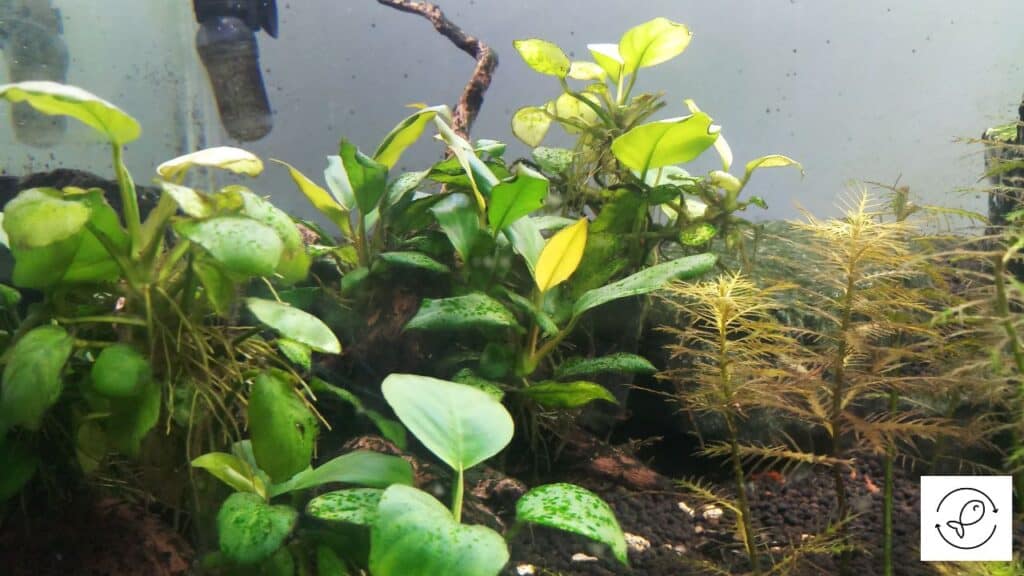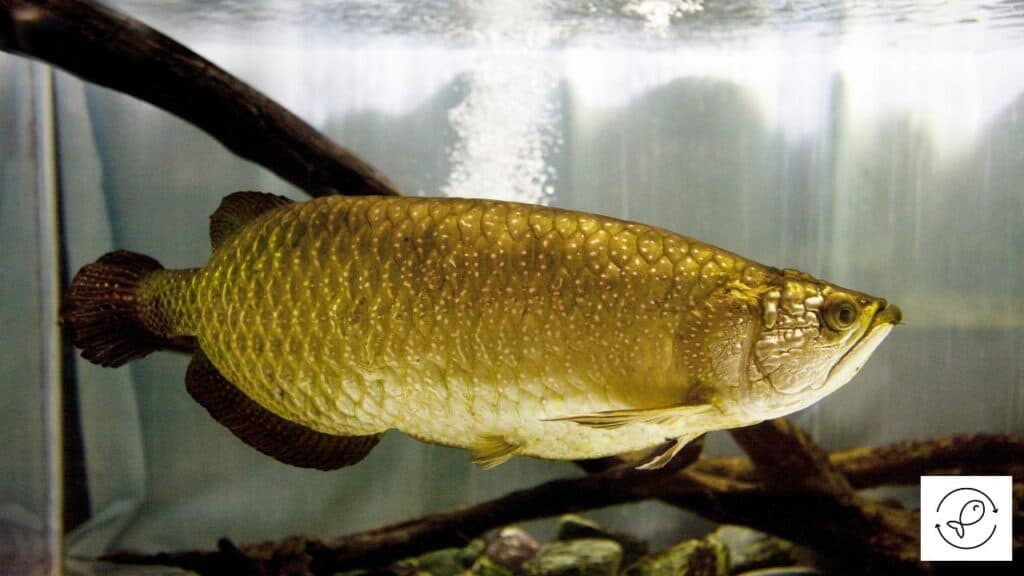Setting up an ideal aquarium for your arowana is crucial for ensuring its health and happiness.
Here are some guidelines to follow.
Aquarium Size
When it comes to keeping arowanas, one of the most important things to consider is the tank size.
These fish can grow large and need ample space to swim around and turn without being cramped.
An aquarium of at least 250 gallons is necessary to house an adult arowana. However, larger tanks are always better for arowanas.
A young arowana can be housed in a 60-gallon tank. However, it must be transferred to a bigger tank as it grows.
The aquarium should also be long and wide with more horizontal space to ensure optimal swimming space for the arowanas.
Also, remember that the tank can become very heavy once filled with water, so ensure that you have a sturdy stand before setting up your aquarium.
Aquarium Lid
Arowanas are known to be surface feeders and leap out of the water when preying on insects or other prey in their natural habitat.
Hence, having a secure lid for your arowana tank is essential to prevent any potential accidents or escapes.
To ensure that the tank lid is sturdy enough, consider investing in a high-quality material that won’t break or crack easily.
Measure the dimensions of your tank and get a custom-fit cover that fits perfectly without leaving any gaps from where the curious fish can escape.
Another important consideration when choosing a lid is its transparency level.
Clear acrylic lids are popular as they offer an unobstructed view of your beautiful pet swimming around while keeping it safely contained within its habitat.
It’s worth noting that some lids can interfere with ventilation if not appropriately designed, leading to poor air circulation and reduced oxygen levels for the fish.
To avoid this problem, choose mesh covers with small holes that allow airflow but keep fin tangles at bay.
Substrate
Arowanas are surface dwellers and are least bothered about substrates than other fish.
Many fishkeepers house arowanas in a bare-bottom tank. However, fine gravel or sand is the best choice if you wish to use a substrate.
Using a substrate can enhance the natural beauty of your tank by providing a more realistic environment for your fish.
It also allows live plants to grow and thrive, providing additional benefits such as oxygenation and filtration.
However, you need to ensure regular substrate cleaning to avoid the buildup of toxins and waste.
Water Parameters
To keep your captive-bred arowanas happy and healthy, it’s best to maintain water conditions that mimic their natural habitat.
These fish prefer slow-moving tropical rivers with warm, acidic water.
The water requirements for arowanas can vary depending on the species. For example, Australian arowanas can tolerate cooler temperatures as well.
While arowanas are not overly sensitive to water chemistry, cleanliness is crucial when keeping large predatory fish like them because they generate a lot of waste.
The ideal water parameters for arowanas are:
Water Temperature: 75°F to 82°F (23.8°C to 27.8°C),
Water pH: 6.5 to 7.0,
Water Hardness (dGH): 8 to 12.
Remember that maintaining consistent and stable water parameters is essential for the health and well-being of all aquarium inhabitants.
Test your water regularly using a reliable kit and perform partial water changes weekly or bi-weekly, depending on how heavily stocked your tank is.
Water Current
Arowanas originate from tropical rivers and prefer stagnant waters.
The surface water is where they usually watch for prey. So a lot of flow can disturb their hunting habits.
You should also avoid powerheads when setting up an arowana tank because these create strong currents that the arowanas will find challenging.
It could stress them and make them uncomfortable. Finding food may also become problematic in such conditions.
Additionally, young arowanas have delicate yolk sacks, which can get harmed easily due to the swift currents or rough surfaces.
You can direct the output of filtration units in a way that it doesn’t affect your arowana much while still ensuring good filtration capabilities.
Aim for creating areas with mild water currents and spaces where the arowanas can relax without being pushed around too much by the waves.
Filtration System
Filtration is crucial for maintaining a healthy and clean environment for arowanas.
Arowanas are large fish with big appetites. So you need a filtration system that can keep up with their waste production.
Listed below are the top 3 filtration systems to use for arowanas.
Sump Filter
A sump is an additional tank or external water reservoir usually installed in the aquarium stand.
This additional tank holds biological and mechanical media and circulates water from your main tank through its chambers.
Canister Filter
Canister filters are also popular among aquarists as they maximize space while offering excellent filtration capabilities.
They are best suited for large tanks as these filters provide superior biological, mechanical, and chemical filtration.
Just make sure to choose one rated for the size of your tank.
Trickle Filter
Another option is the trickle filter which uses layers of plastic boxes filled with media sitting above your aquarium.
Water is pushed by a pump through a spray bar pipe, resulting in trickling over the filtration media inside the boxes.
This maximizes efficiency while saving space.
When choosing any type of filtration system, ensure that you use high-quality media to maximize bacterial growth inside them.
Live Plants

Arowanas prefer an aquarium with live aquatic plants, as they provide natural hiding places and a more realistic habitat.
When stocking live plants in your tank, make sure to choose plants that are hardy and can thrive in tropical freshwater conditions.
Java Ferns are popular for arowanas, as they tolerate low light and high temperatures.
They also need minimal maintenance and are easy to propagate.
Other great choices include Anubias, Vallisneria, and Amazon Sword.
Live plants also have the added benefit of providing oxygen to the aquarium and absorbing nitrates from the water. This helps to keep your tank clean.
Finally, live plants can help create a stunning visual effect in your tank, making it look even more beautiful and naturalistic.
Decorations
Arowanas can be skittish at times. So providing hiding places in the form of decorations like rocks or caves can provide them security.
Plants can be a great addition to an arowana tank as they help purify the water by absorbing nitrates and other toxins.
Rocks can also be used as decoration, but make sure that they don’t have sharp edges that could harm your arowanas or damage their delicate fins.
Sand or gravel can be added at the bottom of the tank to create a natural look.
Driftwood is another popular choice for aquarium decoration. It provides hiding spots for fish and adds a natural look to the tank.
Aim for simplicity when decorating your tank. Too many decorations can clutter up the space and stress the arowanas.
Aquarium Lighting
Arowanas prefer moderate to dim lighting as they live near the surface and in waters stained with tannins.
LED energy-saving lights are recommended as they are efficient and long-lasting.
Also, proper lighting can enhance the natural colors of your arowana and its environment.
Viewing and tanning lights can be considered while setting up your arowana tank.
Viewing lights is vital for all species of arowanas as they are sight feeders and need good lighting to see their prey.
On the other hand, tanning lights can be used to intensify the natural coloration of gold or red arowanas.
It’s important to note that sudden changes in lighting can startle arowanas and cause them to jump out of the tank.
To avoid this, ensure ambient light is in the room before turning on any bright aquarium lights.
Tank Cycling
Cycling is crucial for creating a healthy environment for aquatic pets.
It’s the process of establishing beneficial bacteria that will break down fish waste and prevent harmful toxins from forming in the water.
This is essential before adding any fish to your aquarium, including predatory species like arowanas.
Once established, beneficial bacteria need consistent oxygen flow through surface agitation to thrive.
It’s important not to disrupt this delicate balance by over-cleaning biological filtration media or using chemical additives that may harm these crucial microorganisms.
Tankmates
Arowanas are predatory fish and highly territorial. So they should be housed with tankmates matching their size and aggression.
It’s best to house one arowana fish in a tank as they can get aggressive with each other.
If you wish to keep a group of arowanas, the tank must be substantially large to accommodate all of them.
When it comes to choosing suitable tankmates for your arowana, there are several factors you need to consider.
One thing to keep in mind is the size difference between your arowana and any other fish you want to add.
Arowanas can grow up to 3 feet long, so any other fish in the tank shouldn’t be small enough to get eaten.
Most aquarists house arowanas with semi-aggressive tankmates.
Some popular choices as arowana tankmates are:
- Oscars,
- Jack Dempsey,
- Redtail catfish,
- Pacu,
- Sailfin plecos,
- Bala Sharks,
- Silver Dollars, etc.
Avoid housing peaceful and fin-nipping fish with arowanas.

